March transit ridership pushed up above 60 percent of pre-pandemic numbers for the first time since the pandemic began, according to data released by the Federal Transit Administration last week. Ridership was boosted by the fact that March 2022 had two more weekdays than March 2019. Since April 2022 has one fewer weekday than April 2019, ridership is likely to dip back down below 60 percent in April.
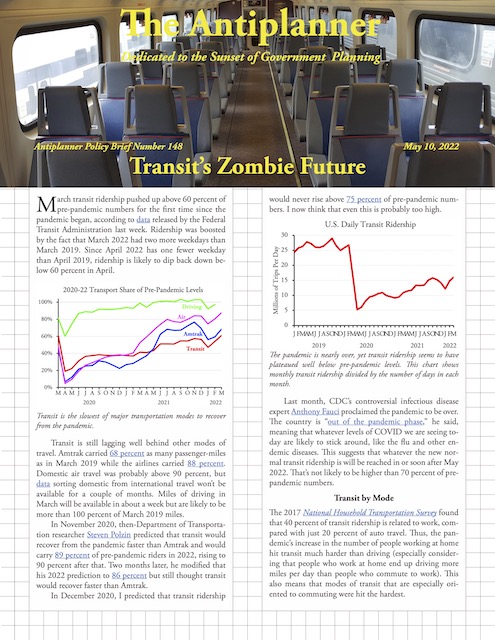 Click image to download a four-page PDF of this policy brief.
Click image to download a four-page PDF of this policy brief.
Transit is still lagging well behind other modes of travel. Amtrak carried 68 percent as many passenger-miles as in March 2019 while the airlines carried 88 percent. Domestic air travel was probably above 90 percent, but data sorting domestic from international travel won’t be available for a couple of months. Miles of driving in March will be available in about a week but are likely to be more than 100 percent of March 2019 miles.
Transit is the slowest of major transportation modes to recover from the pandemic.
In November 2020, then-Department of Transportation researcher Steve Polzin predicted that transit would recover from the pandemic faster than Amtrak and would carry 89 percent of pre-pandemic riders in 2022, rising to 90 percent after that. Two months later, he modified that his 2022 prediction to 86 percent but still thought transit would recover faster than Amtrak.
In December 2020, I predicted that transit ridership would never rise above 75 percent of pre-pandemic numbers. I now think that even this is probably too high.
The pandemic is nearly over, yet transit ridership seems to have plateaued well below pre-pandemic levels. This chart shows monthly transit ridership divided by the number of days in each month.
Last month, CDC’s controversial infectious disease expert Anthony Fauci proclaimed the pandemic to be over. The country is “out of the pandemic phase,” he said, meaning that whatever levels of COVID we are seeing today are likely to stick around, like the flu and other endemic diseases. This suggests that whatever the new normal transit ridership is will be reached in or soon after May 2022. That’s not likely to be higher than 70 percent of pre-pandemic numbers.
Transit by Mode
The 2017 National Household Transportation Survey found that 40 percent of transit ridership is related to work, compared with just 20 percent of auto travel. Thus, the pandemic’s increase in the number of people working at home hit transit much harder than driving (especially considering that people who work at home end up driving more miles per day than people who commute to work). This also means that modes of transit that are especially oriented to commuting were hit the hardest.
As of March, ridership on commuter buses was still under 40 percent while ridership on commuter trains was under 50 percent of pre-pandemic numbers. Many commuter-bus and -rail lines were much worse than that. Commuter buses in Austin, Oakland, and Loudoun County were carrying fewer than 20 percent of pre-pandemic riders, as were commuter trains in Chicago, Maryland, Minneapolis, and San Francisco.
SR=streetcar, FB=ferry boat, YR=hybrid rail, DR=demand response (paratransit); the rest should be self-explanatory.
March heavy-rail ridership was just under 60 percent and light-rail ridership was just over 60 percent of pre-pandemic numbers. Heavy-rail systems in Baltimore, San Francisco, and Washington were well below 40 percent, as were light-rail systems in Baltimore, Pittsburgh, and San Jose. The six systems that the FTA calls hybrid rail, but I prefer to think of as Diesel-powered light rail, averaged 63 percent, but the one in Portland was under 35 percent and one in the Dallas suburb of Denton was under 50 percent.
Other than commuter buses, buses were doing better than rail. Trolley buses carried 63 percent, bus-rapid transit lines carried 70 percent, and the remaining conventional buses (which the FTA calls motor buses) carried 66 percent of pre-pandemic numbers. Again, there was wide variation: trolley buses in Boston were under 20 percent; bus-rapid transit lines in Fort Collins and Orlando were under 40 percent; and conventional buses in, among many other places, Detroit, Durham, Madison, Marin County, and Miami were under 40 percent.
Demand responsive transit, meaning paratransit for elderly and disabled riders, was doing best of all at nearly 75 percent, probably because it was least dependent on commuting. Van pooling, which is entirely dependent on commuting, was still doing fairly well at 57 percent, while streetcars were under 50 percent.
Predicting Long-Term Ridership
Several factors are going to reduce future transit ridership below pre-pandemic levels, and many of them are at least roughly quantifiable. Most important is a permanent increase in the number of people working at home. The Census Bureau’s American Community Survey found that 5.7 percent of American workers worked at home in 2019. A survey conducted in May 2020 found that the pandemic had increased this to more than 35 percent of American workers.
“Office-based business and professional occupations were most likely to implement remote work,” another survey found. Since a disproportionate share of those business and professionals work in downtowns, and downtown commuters form the core of transit ridership, the increase in telecommuting had a disproportionate effect on transit.
The American Community Survey found that the number of people working at home in 2020 was 165 percent greater than in 2019. This reduced the number of people driving alone to work by 13 percent, the number carpooling by 15 percent, and the number of people using “other” means, including bicycling and walking, by 13 percent. But it reduced the number taking transit by 38 percent. The 2020 survey numbers cover the entire year, so the decline during the pandemic months of the year must have been even greater.
Telecommuting thus has around twice the impact on transit as on other modes of commuting. If the share of people working at home on any given day in the post-pandemic era is 20 percent, or about 14 percent more than in 2019, then transit is going to lose 25 to 28 percent of its riders.
A secondary impact is congestion. Many people ride transit to avoid congestion. Telecommuting will take vehicles off the road during rush hour, which will allow some transit riders to drive on less-congested roads.
A third effect will be the dispersal of downtown jobs to other parts of urban areas, where transit is less effective. However, this effect will be small. Target is moving its headquarters out of downtown Minneapolis. Standard Insurance and other companies are moving out of downtown Portland. Chase is moving out of its eponymously named office buildings in downtown Dallasand downtown Columbus. However, these office buildings aren’t going to disappear. Instead, their owners will reduce the rents and attract other tenants.
More significant is the movement of people to distant suburbs or exurban locations. The Census Bureau’s 2021 population estimates show that people are leaving large dense cities and suburbs and moving to lower-density suburbs, smaller urban areas, and exurban areas. That movement is still taking place and will hurt transit because transit service is ineffective in such areas.
People who, before the pandemic, spent five hours a week commuting to and from work who are now asked to work in offices only three days a week can live almost twice as far away from work and still not spend more than five hours a week commuting. However, such exurbanites are not likely to live near transit service, so when they commute, they will be driving.
Finally, a small but significant share of people who rode transit before the pandemic are simply not going to return to transit out of fear of both infectious diseases and rising crime rates. The authors of the study that concluded that 20 percent of people would continue working at home after the pandemic also found that less than half of people planned to fully return to pre-COVID activities and “a persistent 10 to 15 percent say they would not return to them at all.” Among the activities people might not return to is transit commuting.
Transit agencies aren’t helping themselves by encouraging, and in some cases requiring, transit riders to continue wearing masks. This sends a clear signal to potential transit riders that, even as the rest of society gets back to normal, transit is still unsafe to use.
Some of this 10 to 15 percent will overlap with people who are telecommuting or have moved to exurban areas. But a small share of people who otherwise might still ride transit are probably going to stop.
Estimates of the effects of each of these factors can hardly be precise, but when all the factors—telecommuting, less congestion, dispersion of jobs and residences, and the fear factor—are added up, it is hard to imagine that transit ridership will ever return to more than 70 percent of what it was before the pandemic.
Transit by Urban Area
To be fair, transit ridership already has recovered to more than 70 percent of pre-pandemic levels in some urban areas. Among the nation’s top fifty urban areas, these include Miami (75%), San Diego (74%), Tampa (77%), Kansas City (78%), Salt Lake City (71%), Nashville (72%), Richmond (73%), Bridgeport (75%), and Raleigh (78%). However, these are all urban areas where transit’s share of commuting was already low: 3 percent in Miami and San Diego, for example, and 1 percent in Tampa and Kansas City.
One study says that transit is recovering fastest in regions where it carries a large number of “essential workers.” But that is just rhetoric, effectively redefining low-income, transit-dependent workers as essential workers. Their work isn’t any more essential than the work of people who have cars, no matter what their income levels.
The American Community Survey found that just under 40 percent of transit commuters in 2019 lived in households without cars, making most of them dependent on transit. The survey also found that 57 percent of transit commuters earned more than $35,000 a year, and thus could easily afford cars if they wanted to, thus making them transit “choice” riders. Due to the pandemic, transit is going to lose most of its choice riders and keep most of its transit-dependent riders.
Except New York, which has the lowest rate of auto ownership of any major U.S. urban area, transit is recovering at slower than average rates in the regions with the largest numbers of down town jobs.
Before the pandemic, almost 70 percent of transit ridership and transit commuting took place in just seven urban areas: New York, Chicago, Philadelphia, Washington, Boston, San Francisco-Oakland, and Seattle. At least two-thirds of transit commuters in these seven areas were choice commuters, and most of these will be permanently lost to transit after the pandemic. Notably, except for New York (which has the lowest rate of car ownership of any major U.S. city), transit’s recovery has been slower than average in these regions.
Transit Industry Response
Transit agency responses to this dim future have been rather lackadaisical. Thanks to $70 billion COVID relief funds, they are currently awash in cash and have enough to continue operating, even without any riders, for at least another year. The $40 billion dedicated to transit in the infrastructure bill means that many agencies are more focused on planning and building expensive new infrastructure that few people will use than on recovering transit riders lost to the pandemic.
Transit’s biggest flaw is that it really only works for downtown workers. Commuters from one suburb to another—which is most of them—might have to spend two hours on transit to take a trip that is just 15 minutes by car. Prior to the pandemic, more than half of the people who worked in downtown Chicago took transit to work. While more than 200,000 people worked near O’Hare Airport, less than 5 percent of them took transit to work. O’Hare is on an elevated rail line, but unlike downtown it is not the hub of a hub-and-spoke system.
Transit agencies could be taking this opportunity to redesign their networks so they can be more useful to people who work in major job centers outside of downtowns. None of them are, partly because they fear the political impact of losing some existing riders would be greater than they could gain from getting new riders. Dallas recently revised its bus network, but the revision still doesn’t provide any hubs other than downtown.
Instead, the most common solution offered to low ridership is to offer free transit for at least some riders. This could potentially cost up to $9 billion to $16 billion a year (the total transit fares collected in 2020 and 2019), but it isn’t going to change the fact that people are working at home, they’ve moved their homes to places that are poorly served by transit, many still don’t trust that transit can be safe from infectious diseases and crime, and that transit, even if free, remains far slower than driving to most destinations.
Instead of going out of their way to make themselves more useful to more riders, transit agencies seem to be trying to figure out how they can persuade voters and appropriators to keep subsidizing transit even if it carrying less than 70 percent of pre-pandemic riders. A recent article in the Chicago Sun-Times pleaded that “our cultural and social survival depends” on the Chicago Transit Authority. Rather than focus on congestion relief or greenhouse gas reductions, transit agencies claim that their subsidies are needed for a socially “equitable COVID recovery.”
This is all bull, of course. Nationwide, less than 5 percent of people earning under $25,000 a year took transit to work in 2019. Even in the Chicago urban area, it was under 12 percent. Since most of the taxes used to subsidize transit are regressive, that means that the vast majority of low-income workers are disproportionately paying taxes to subsidize transit rides they aren’t taking. Reducing fares or otherwise increasing funding only increases the inequitability of transit subsidies.
The one thing that may help transit ridership is high fuel prices. In recent decades, transit ridership has been more sensitive to fuel prices than just about anything else. The war in Ukraine and related shake ups of the global trading system may take several years to work out.
However, Americans have a history of responding to high fuel prices by initially driving less and then buying more fuel-efficient cars. Buying electric vehicles in large numbers could swamp any benefits to transit resulting from high prices.
Zombie Transit Agencies
Five years ago, I predicted that by 2030 most transit systems outside of New York City would be run by zombie agencies that existed mainly to repay the heavy debts they incurred building expensive infrastructure and fulfill their unfunded pension and health care obligations. Any actual transit services they provided would be the minimum necessary to justify the tax subsidies they would need to cover these debts and obligations.
I thought this would happen because driverless cars would capture most transit riders. Driverless cars are taking a little longer than I expected, but the prediction still seems realistic due to the pandemic.
Transit agencies should focus on trying to make themselves more useful to more people. Agencies that are unwilling to do that should expect to fade away and disappear in the next few years.
I’ve posted an enhanced spreadsheet showing monthly transit ridership by transit agency and mode through March 2022. The FTA raw data are in cells A1 through IR2352. Annual totals are in columns IS through JM. Column JN shows March 2022 ridership as a percent of March 2019. Column JO shows March 2022 ridership as a percent of March 2021. Mode totals are in rows 2254 through 2275. Agency totals are in rows 2280 through 3279. Urbanized area totals are in rows 3285 through 3773.

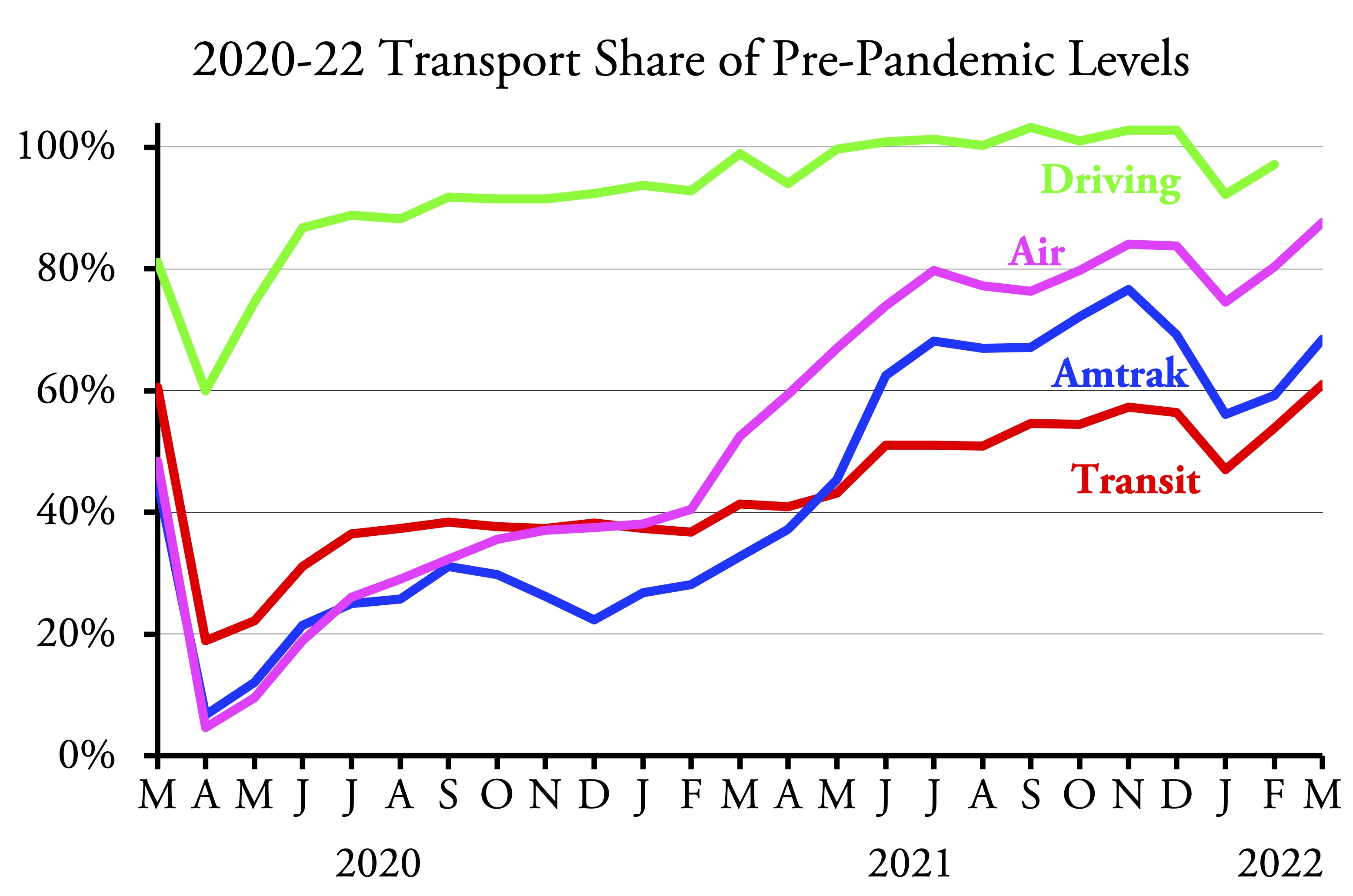
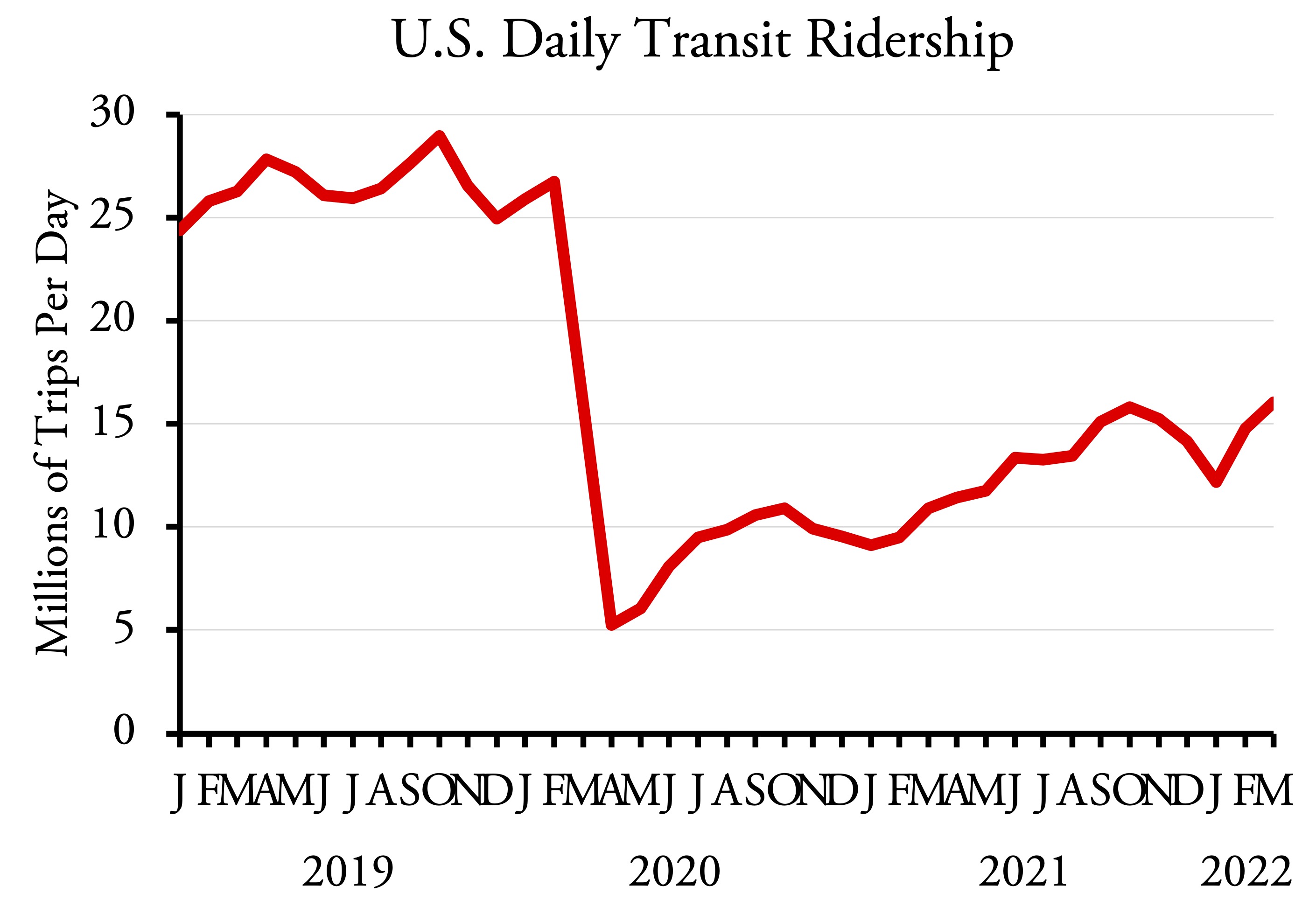
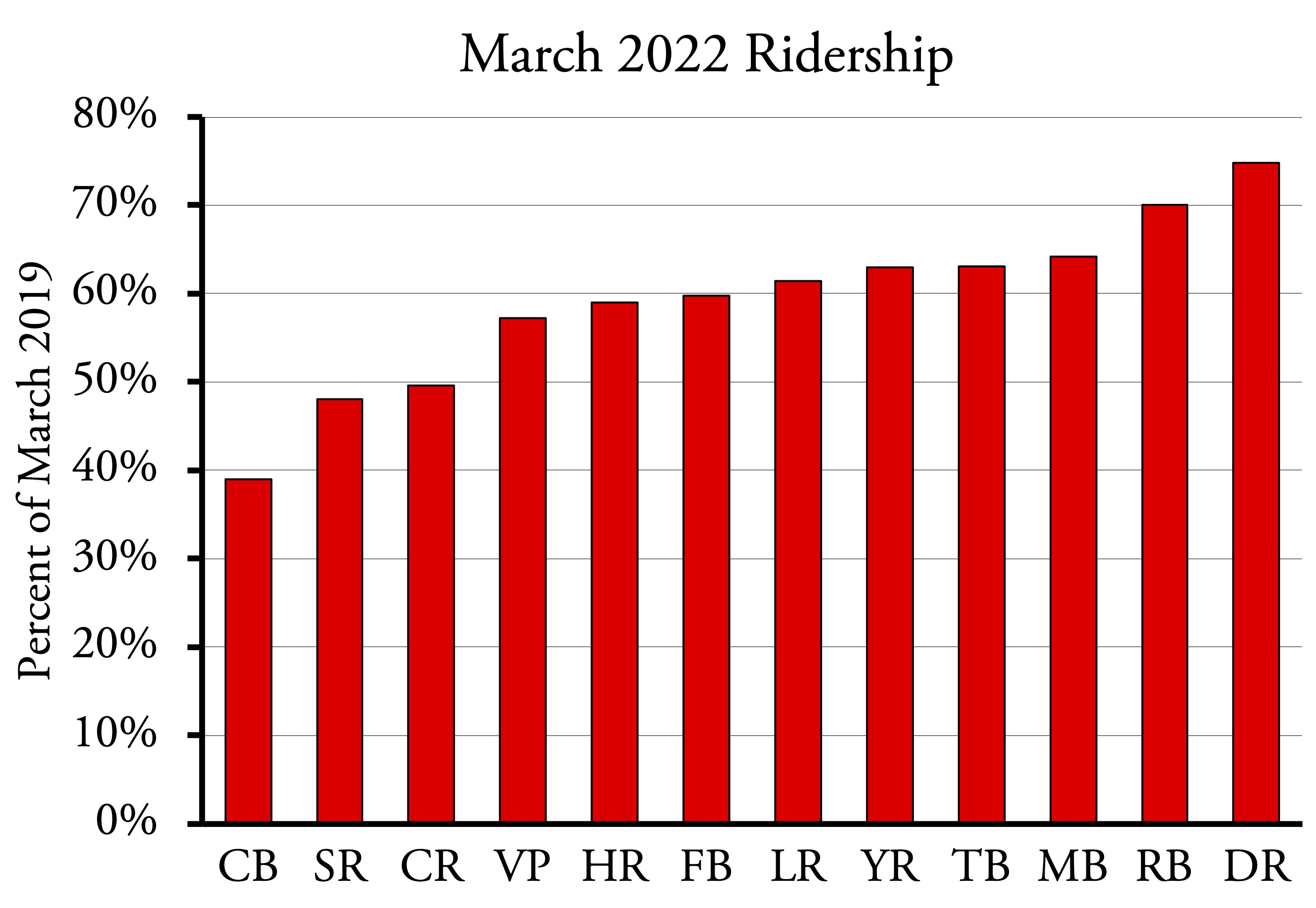
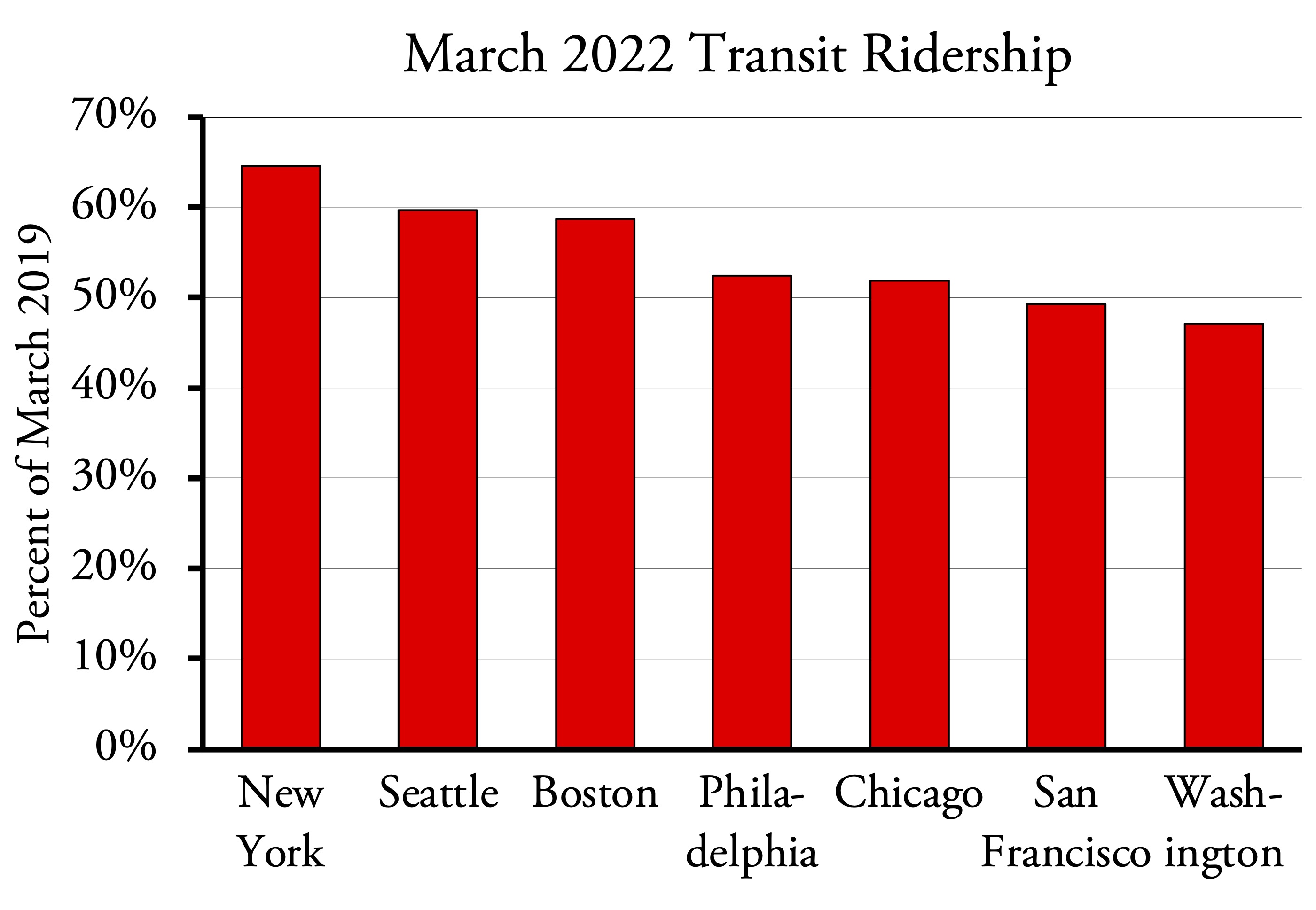







meaning that whatever levels of COVID we are seeing today are likely to stick around,”
YEAH, it’s part of the ecosystem now. Its not going away, thank China for that. “Tofu-dreg project” is a phrase used in the Chinese-speaking world to describe a poorly constructed building. on April 29, a commercial street building in Changsha, Hunan Province suddenly collapsed. A video on the Internet shows that, along with a loud bang and smoke and dust, the 8-story building instantly became 2-stories of broken walls. 53 people died.
https://www.youtube.com/watch?v=RElGXLwWTvI
Including this building Lianlong’s center for disease control in july 2021, no wonder Corona escaped.
Just a point of order, so to speak. The news is a little muddled + confusing. Target is not moving it’s actual headquarters out of downtown Minneapolis.
They have been for years shifting jobs from various location including downtown to corporate campus in Brooklyn Park. Since the turn of the century when they opened the 340 acre campus, they’ve had several announcements where of moving thousands at a time there. This shift was going on long before COVID. I mention this because downtowns have had this issue for quite some time, their office space has been overpriced.
Recently Target canceled a lease about 10 years early for around a million square feet of office space in downtown Minneapolis. So that’s maybe another 3K – 4K workers that will be once in a blue going downtown for some meetings, more often likely going to the Brooklyn Park campus. And mostly just working from home.
Ya, a million square feet. UFFDUH!
The overall problem is the same, there’s thousands of Target workers no longer going downtown. And when they do, they’re going to the Brooklyn Park campus. Where the official HQ isn’t all that important for this. There’s thousands of transit riders that’ll never use it again. Gone.
Almost as bad, Wells Fargo’s been shrinking. They cut 20,000 positions last year across the company. WF is the 3rd largest employer in downtown Minneapolis. Those workers there not cut have been working remotely several days / week.
Metro Transit has been suspending and cutting routes. If you look at their list you’ll note a disproportionate number of express routes. Those downtown workers ain’t riding and they ain’t coming back.